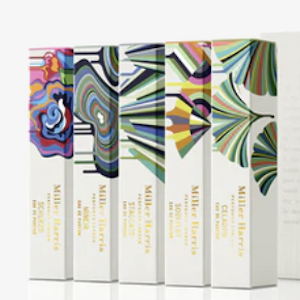Radiant; The Scent of Words
By Jo Phillips
Perfume is a story, it is a set of emotions captured in a bottle. Smelling a perfume (not every perfume of course) can evoke a memory: suppose you smell orange, cardamom and cinnamon then (as long as you celebrate it) you are very likely to think of happy memories of Christmases spent with loved ones. That is the core of how perfume works. It taps into our loves, our happiness, our joys and even the saddest of emotions.
This is not an accident, of course, because the parts of the brain that deal with memory and smell are closely linked. Simply put, when we smell, our olfactory neurones in the upper part of the nose generates an impulse that is passed to the brain along the olfactory nerve. This part of the brain processes the signal and passes information about the smell to other areas closely connected to it, collectively known as the limbic system. The limbic system comprises a set of structures within the brain that are regarded by scientists as playing a major role in controlling mood, memory, behaviour and emotion.
Now we understand this, let’s take it a step further directly into the idea of telling a story, and how a scent can help aid the painting of a picture within a storybook.
Author Stacy Halls recounts just such an experience when she started to write her much-acclaimed novel The Familiars.

In early 2017, Halls sat down to start The Familiars, having saved a stunning Baies dyptique candle she received as a Christmas gift to burn as she wrote. This heady delicious scent of rose and blackcurrant will always bring her back to writing the book, as she struck the match in order to have the evocative scent accompany her through her journey in words.
What is more fascinating is that once the book was finished, she was able to go through the diptyque candle collection and pick out a number of scents she could tie into parts of the narrative. She looked for fragrances that replicated in smell the feel of the emotions she captured in the book.
For example, take the candle ‘Cannelle’, which is built around a cinnamon fragrance which Halls says reminds her of the main character Fleetwood. Halls says she can picture this lady of the house in the great hall surrounded by a feast such as Christmastide, warm, rich and powerful just like her heroine in The Familiars.
Or ‘Aubepine,’ a hawthorn scented candle with an almond marzipan hue to it. Her character Fleetwood loves marzipan and orders boxes of it from her favourite confectioner in London, so it was a natural choice for a scent that Stacy imagines surrounds Fleetwood.
She also mentions ‘Mousses,’ a moss hue, which of course is the perfume of the forest floor that surrounds the great house that Fleetwood lives in. Or ‘Feu de Bois,’ the perfume of firewood which sums up the horse and the hunting party and post-event warm fire, wood and smoke.

A possibly easy one to imagine is ‘Feuille de lavande’ (lavender leaf). Lavender, often used in the time period as a natural herb and still enjoyed and celebrated today, is used in the book to cure bad dreams and evoke a good night’s sleep. Halls even mentions her grandma having bunches of it around her home.
The book is so evocative that it has been lauded as a wonderful insight into the world of seventeenth-century industrial Lancashire, even more impressive given that this is her debut.
As much as it is based in the 17th Century, The Familiars has a modern edge, as it is a story of two women struggling to fight against the expectation and superstition of their age. It brings in the infamous witch trials of the time where many many women who practiced the art of assisting in childbirth were held to be witches.
The is nothing more powerful than a well written engrossing book that draws you into a story that comes alive in pictures in your own mind. If you have yet to read The Familiars, get a copy and consider a trip to the diptyque store to pick up the scents that will elevate your emotive experience through this literary journey.



